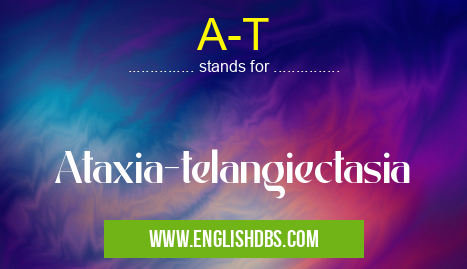What does A-T mean in NURSING
Ataxia-telangiectasia (A-T) is a genetic disorder that affects multiple systems in the body. It is an inherited condition due to a mutation in the ATM (ataxia telangiectasia mutated) gene, which creates a susceptibility to developing certain types of cancer and other health complications. A-T patients typically have difficulty with coordination, abnormal growth, diabetes, increased sensitivity to radiation and immunodeficiency as well.

A-T meaning in Nursing in Medical
A-T mostly used in an acronym Nursing in Category Medical that means Ataxia-telangiectasia
Shorthand: A-T,
Full Form: Ataxia-telangiectasia
For more information of "Ataxia-telangiectasia", see the section below.
Symptoms
The most common symptom of A-T at birth is unsteady movement or trouble walking properly. These symptoms worsen over time due to progressive neurological damage. Other complications can include problems with vision and hearing, difficulty speaking, weak muscles, poor balance and coordination and an unusually small head size. Patients may also suffer from infections more often than those without A-T as their immune system does not function properly. In addition to physical symptoms, mental impairment and learning disabilities can also affect those living with A-T.
Diagnosis
Diagnosing Ataxia telangiectasia usually requires a combination of clinical tests including blood work, neuroimaging studies such as MRI or CT scans, complete physical exams and genetic testing for ATM gene mutations. Most diagnoses are made before a child turns three years old though occasionally late diagnosis can occur when there are more mild symptoms present at an older age.
Treatment
There is no cure for Ataxia telangiectasia but there are treatments available that can help manage the symptoms of the disorder. Physical therapy can be used to improve mobility and coordination while occupational therapy is often used to address everyday activities like dressing or feeding oneself. Speech-language therapy may be required if speech becomes impaired or communication difficulties arise from mental retardation or motor slowness issues. Medications like antibiotics may be prescribed for recurrent infections while anticonvulsants may be necessary for associated seizures.
Essential Questions and Answers on Ataxia-telangiectasia in "MEDICAL»NURSING"
What is Ataxia-telangiectasia?
Ataxia-telangiectasia (A-T) is a rare, inherited disorder that affects the nervous system and other body systems. It can cause problems with movement, breathing, learning, and other functions. It is caused by mutations in the ATM gene which codes for a protein called ataxia telangiectasia mutated.
What are the symptoms of Ataxia-telangiectasia?
Symptoms of A-T usually appear in early childhood and may include clumsiness or unsteady gait, poor coordination, jerky eye movements, facial telangiectasias (small dilated blood vessels on the face), immune system deficiencies, difficulties with speech and language development, and recurrent respiratory infections.
Who is at risk for Ataxia-telangiectasia?
Ataxia-telangiectasia affects people of all races and ethnicities worldwide. About 1 in 100,000 to 150,000 people have it. The condition is inherited as an autosomal recessive trait which means both parents must pass on a mutated ATM gene to their child for them to be affected by the condition.
How is Ataxia-telangiectasia diagnosed?
Diagnosis of A-T typically involves taking family history into account as well as physical examination to identify characteristic features such as facial telangiectasias and neurological tests such as brain scans or genetic testing for the ATM gene mutation.
What treatments are available for Ataxia-telangiectasia?
There is no cure for A-T; however there are treatments to manage symptoms including physical therapy or occupational therapy to assist with coordination issues or speech/language therapy to improve communication abilities if necessary. A healthy diet with sufficient calories and certain supplements are also used to help maintain good health status in individuals affected by this condition.
Is there any research being done regarding Ataxia-telangiectasia?
Yes! There are many ongoing clinical trials studying potential therapies for A-T ranging from stem cell treatments to drugs that either address common symptoms or target specific underlying causes of A-T related diseases like cancer or respiratory infections. Additionally, there are an increasing number of studies examining potential biomarkers associated with the progressions of this disease in order to better measure efficacy during treatment trials.
What complications could arise from having Ataxia-telangiectatisa?
Individuals with A-T often experience other conditions associated with their condition such as cancer (particularly blood cancers), diabetes mellitus type 2, delayed growth/developmental issues such as obesity or learning disabilities due to delayed cognitive development caused by impairment of the cerebellum in addition to increased susceptibility towards infection due immunodeficiency.
Are there any support groups available for people affected by Ataxia-telangiectasia?
Yes! Many national organizations provide resources and support specifically tailored towards those living with A - T like ATAA (Ataxia Telangietctasia Advocacy & Awareness) who have programs available aimed at patient education, raising awareness about this rare genetic disorder along with providing emotional support through online forums & virtual support groups hosted by experienced professionals.
Final Words:
Ataxia telangiectasia (A-T) is a genetic disorder that affects many areas in the body including balance, movement, vision and hearing as well as immune system functioning. Diagnosis usually occurs during early childhood though late diagnosis is possible with milder symptoms that don't become apparent until later on in childhood or adulthood. While there is currently no cure for this disorder treatments such as physical therapy, occupational therapy and medications can be used to help manage the many symptoms caused by A-T.
